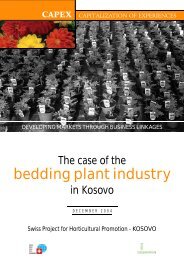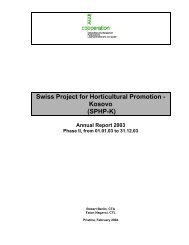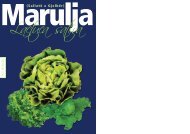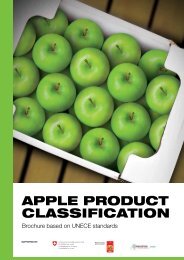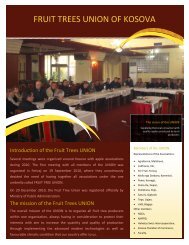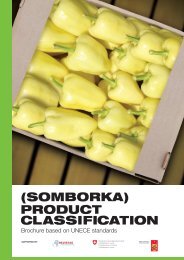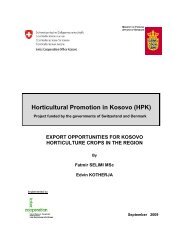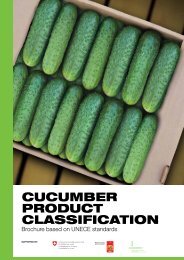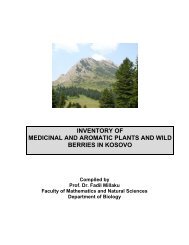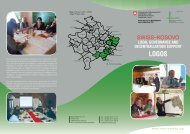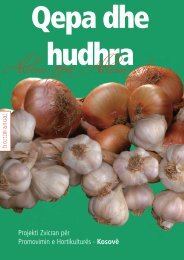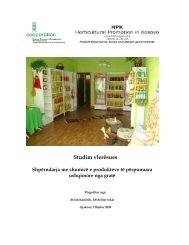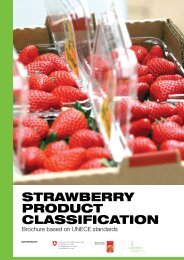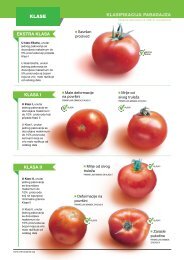Broshura Klasifikimi i Domates English.pdf - HELVETAS
Broshura Klasifikimi i Domates English.pdf - HELVETAS
Broshura Klasifikimi i Domates English.pdf - HELVETAS
You also want an ePaper? Increase the reach of your titles
YUMPU automatically turns print PDFs into web optimized ePapers that Google loves.
Tomato product<br />
classification<br />
Brochure based on UNECE standards<br />
SUPPORTED BY:
Product<br />
classes<br />
Tomato product classification<br />
Brochure based on UNECE standards<br />
Extra class<br />
Within a package of<br />
Extra Class tomatoes a<br />
maximum of 5% of Class I<br />
product is allowed<br />
Perfect<br />
product<br />
Extra<br />
class<br />
Within a package of Extra<br />
Class tomatoes a maximum<br />
of 5% of product with a<br />
slightly different colour is<br />
allowed<br />
Class I<br />
Within a package of<br />
Class I tomatoes a<br />
maximum of 10% of<br />
Class II product is<br />
allowed<br />
Within a package of<br />
Class I tomatoes a<br />
maximum of 10%<br />
of product with a<br />
slightly different<br />
colour is allowed<br />
Slight superficial<br />
blemishes<br />
Limit accepted in Class I<br />
Class I<br />
Botrytis<br />
ghost spots<br />
Limit accepted in Class I<br />
Class I<br />
Class II<br />
Within a package of<br />
Class II tomatoes,<br />
it is allowed a<br />
maximum of 10%<br />
of product that<br />
does not fulfil the<br />
minimum limits of<br />
Class II<br />
Within a package of<br />
Class II tomatoes,<br />
it is allowed a<br />
maximum of 10% of<br />
product that differs<br />
from the rest of the<br />
product.<br />
Botrytis<br />
ghost spots<br />
Limit accepted in Class II<br />
Superficial<br />
blemishes<br />
Limit accepted in Class II<br />
Class II<br />
Class II<br />
Class II<br />
Healed<br />
cracks<br />
Limit accepted in<br />
Class II<br />
www.intercoopkos.org
Not<br />
allowed for<br />
classification<br />
Tomato product classification<br />
Brochure based on UNECE standards<br />
Damaged<br />
tomato<br />
NOT<br />
ALLOWED<br />
NOT<br />
ALLOWED<br />
NOT<br />
ALLOWED<br />
Fresh cracks<br />
No stalk<br />
NOT<br />
ALLOWED<br />
Pseudomonas<br />
NOT<br />
ALLOWED<br />
Signs<br />
of rotting<br />
Treatment<br />
residues<br />
NOT<br />
ALLOWED<br />
Unhealed<br />
damage<br />
caused by hail<br />
NOT<br />
ALLOWED<br />
Blossom-end rot<br />
NOT<br />
ALLOWED<br />
NOT<br />
ALLOWED<br />
Caterpillar<br />
NOT<br />
ALLOWED<br />
Damage<br />
by snails<br />
Damage<br />
by insects<br />
NOT<br />
ALLOWED<br />
www.intercoopkos.org
Post-Harvest:<br />
Damages and<br />
diseases<br />
Tomato product classification<br />
Brochure based on UNECE standards<br />
Damages<br />
NOT<br />
ALLOWED<br />
Chilling injury<br />
NOT<br />
ALLOWED<br />
Damage from<br />
wooden crate<br />
NOT<br />
ALLOWED<br />
NOT<br />
ALLOWED<br />
Not fresh in<br />
appearance<br />
Presence of cracks<br />
Diseases<br />
NOT<br />
ALLOWED<br />
NOT<br />
ALLOWED<br />
NOT<br />
ALLOWED<br />
Bacteria soft rot Black spot<br />
NOT<br />
ALLOWED<br />
NOT<br />
ALLOWED<br />
NOT<br />
ALLOWED<br />
Bacterial spot<br />
Anthracnose<br />
Product rotting<br />
www.intercoopkos.org
Packaging<br />
Tomato product classification<br />
Brochure based on UNECE standards<br />
Proper packaging<br />
Proper packaging of tomatoes in carton box<br />
The visible part of the product should uniformly represent the whole content<br />
Proper positioning<br />
of crates on a palette<br />
improper packaging<br />
Improper<br />
classification and<br />
packaging<br />
Improper packaging<br />
Too much product in<br />
a carton box<br />
Wooden crate overfilled<br />
with tomatoes<br />
Packaging of tomatoes in wooden boxes is not<br />
recommended due to the higher possibility for<br />
product damage or contamination<br />
Annotation on the packaging<br />
Made in Kosovo<br />
Mamusha tomatoes<br />
Variety Bella Newton Izmir<br />
Type<br />
Rounded<br />
Class Extra I II<br />
Size 3 4 4.5 5<br />
Gross Weight 5 kg 6 kg<br />
Mamusha tomatoes<br />
Variety Bella Newton Izmir<br />
Type<br />
Rounded<br />
Class Extra I II<br />
Size 3 4 4.5 5<br />
Gross Weight 5 kg 6 kg<br />
Made in Kosovo<br />
www.intercoopkos.org
Classification<br />
by size<br />
Tomato product classification<br />
Brochure based on UNECE standards<br />
The sizes of tomatoes in the Kosovo market are mainly distinguished based on the number<br />
of tomatoes lined in the width of the standard package (of dimensions 30cm x 40cm).<br />
The sizes used are: 3, 4, 4.5 and 5. The sizing is mandatory for Class Extra and Class I. The<br />
mixed size can be used only for Class II.<br />
Size 5<br />
(5 tomatoes per row – diameter 47-57 mm)<br />
Size 4.5<br />
(space for 4.5 tomatoes – diameter of 57-67)<br />
Size 4<br />
(4 tomatoes in a row – diameter of 67-82 mm)<br />
Size 3<br />
(3 tomatoes per row – diameter 82+mm)<br />
Mixed size<br />
Prepared by: Edvin Kotherja & Stuart Pettigrew •Supported by: Basri Pulaj • Photos: OECD<br />
www.intercoopkos.org<br />
Design:



